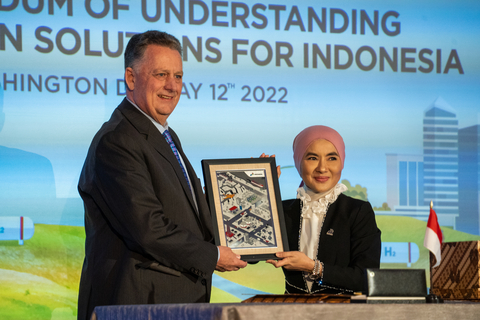Chevron Corporation (NYSE: CVX), through its subsidiary Chevron New Ventures Pte. Ltd. (Chevron), and Indonesia’s PT Pertamina (Persero) today announced a partnership to explore potential lower carbon business opportunities in Indonesia.
This press release features multimedia. View the full release here: https://www.businesswire.com/news/home/20220512005761/en/

Jay Pryor, Vice President of Corporate Business Development for Chevron, and Nicke Widyawati, President Director & CEO of PT Pertamina (Persero), commemorate the signing of an MoU to explore lower carbon opportunities in Indonesia. (Photo: Business Wire)
Aimed at serving local and potentially regional customers, Chevron and Pertamina plan to consider novel geothermal technologies; carbon offsets through nature-based solutions; carbon capture, utilization, and storage (CCUS); as well as lower carbon hydrogen development, production, storage, and transport.
The partnership follows the signing of a Memorandum of Understanding (MoU) in Washington, DC, attended by Jay Pryor, Vice President of Corporate Business Development for Chevron, Nicke Widyawati, President Director & CEO of PT Pertamina (Persero), Luhut B. Pandjaitan, Coordinating Minister for Maritime and Investment Affairs of the Republic of Indonesia, and Bahlil Lahadalia, Minister of Investment/Head of BKPM.
“We are excited to build upon Chevron’s nearly 100-year history in Indonesia. This MoU demonstrates Chevron and Pertamina’s commitment to continue identifying lower carbon opportunities through collaboration and partnership between Chevron, national energy companies, and governments, all of which have a shared interest in advancing national energy transition,” said Jeff Gustavson, President of Chevron New Energies. “Through our potential work in Indonesia, and the entire Asia Pacific region, we hope to provide affordable, reliable, ever-cleaner energy, and help the industries and customers who use our products advance their lower carbon goals.”
The partnership between Chevron and Pertamina is part of efforts from both companies to support the Government of Indonesia’s net zero emission target in 2060. Pertamina is committed to increasing its renewable energy mix from 9.2 percent in 2019 to 17.7 percent in 2030.
“Pertamina, as the largest state-owned energy company in Indonesia, remains committed to accelerating energy transition in accordance with the government's targets. This partnership is a strategic step for Pertamina and Chevron to complement each other’s strengths and develop lower carbon energy projects and solutions to promote energy independence and domestic energy security," said President Director & CEO of Pertamina Nicke Widyawati.
Indonesia, as the second largest country with geothermal installed capacity, has developed geothermal since 1974. Currently, Pertamina through its Subholding Power & NRE, has a total installed geothermal capacity of 1,877 megawatts (MW) originating from 13 geothermal work areas, of which 672 MW come from work areas that are operated independently and 1,205 are joint operation contracts (JOC). The independently operated work area with a total capacity of 672 MW includes Sibayak Area at 12 MW, Lumut Balai Area at 55 MW, Ulubelu Area at 220 MW, Kamojang Area at 235 MW, Karaha Area at 30 MW, and Lahendong Area at 120 MW.
In addition, Pertamina is also diversifying geothermal development; an ongoing green hydrogen pilot project, among others, is being developed in the Ulubelu Area with a production target of 100 kg per day, and brines to power which is being developed in the Lahendong Area and has a potential capacity of 200 MW out of several other work areas.
Nicke added, in collaboration with various parties, Pertamina is also developing the implementation of Carbon Capture and Storage (CCS) and Carbon Capture, Utilization, and Storage (CCUS) as one of the company's strategies to reduce carbon emissions in two oil and gas fields namely Gundih and Sukowati. Pertamina is also reviewing the commercialization of the application of CCUS technology in the Sumatra region.
The Indonesian government currently has an energy transition roadmap as part of the Grand National Energy Strategy. In the roadmap, the use of renewable energy is targeted to reach 23% by 20251.
Meanwhile, the government has also acknowledged the importance of a collaborative approach to achieve lower carbon goals.
“Without a doubt, efforts to boost lower carbon energy projects cannot be done alone. In the future, we hope that world-class oil and gas companies, such as Pertamina and Chevron, can partner to further reduce carbon emissions and advance energy transition as mandated by the Government of Indonesia," concluded Luhut B. Pandjaitan.
About Chevron
Chevron is one of the world’s leading integrated energy companies. We believe affordable, reliable and ever-cleaner energy is essential to achieving a more prosperous and sustainable world. Chevron produces crude oil and natural gas; manufactures transportation fuels, lubricants, petrochemicals and additives; and develops technologies that enhance our business and the industry. We are focused on lowering the carbon intensity in our operations and seeking to grow lower carbon businesses along with our traditional business lines. More information about Chevron is available at www.chevron.com.
About PT Pertamina (Persero)
PT. Pertamina (Persero) is a state-owned enterprise that manages the oil and gas exploration in Indonesia since 1957. As a Holding in the Energy sector which was inaugurated by the Indonesian Ministry of SOEs on June 12, 2020, Pertamina now plays a strategic role in leading its six Subholdings which includes Upstream Subholding, Gas Subholding, Refining & Petrochemical Subholding, Power & New Renewable Energy Subholding, Commercial & Trading Subholding, as well as International Marine & Logistics Subholding. More information about Pertamina is available at www.pertamina.com.
CAUTIONARY STATEMENTS RELEVANT TO FORWARD-LOOKING INFORMATION FOR THE PURPOSE OF “SAFE HARBOR” PROVISIONS OF THE PRIVATE SECURITIES LITIGATION REFORM ACT OF 1995
This news release contains forward-looking statements relating to Chevron’s operations and energy transition plans that are based on management's current expectations, estimates and projections about the petroleum, chemicals and other energy-related industries. Words or phrases such as “anticipates,” “expects,” “intends,” “plans,” “targets,” “advances,” “commits,” “drives,” “aims,” “toward,” “forecasts,” “projects,” “believes,” “approaches,” “seeks,” “schedules,” “estimates,” “positions,” “pursues,” “may,” “can,” “could,” “should,” “will,” “budgets,” “outlook,” “trends,” “guidance,” “focus,” “on track,” “goals,” “objectives,” “strategies,” “opportunities,” “poised,” “potential,” “ambitions,” “aspires” and similar expressions are intended to identify such forward-looking statements. These statements are not guarantees of future performance and are subject to certain risks, uncertainties and other factors, many of which are beyond the company’s control and are difficult to predict. Therefore, actual outcomes and results may differ materially from what is expressed or forecasted in such forward-looking statements. The reader should not place undue reliance on these forward-looking statements, which speak only as of the date of this news release. Unless legally required, Chevron undertakes no obligation to update publicly any forward-looking statements, whether as a result of new information, future events or otherwise.
Among the important factors that could cause actual results to differ materially from those in the forward-looking statements are: changing crude oil and natural gas prices and demand for the company’s products, and production curtailments due to market conditions; crude oil production quotas or other actions that might be imposed by the Organization of Petroleum Exporting Countries and other producing countries; technological advancements; changes to government policies in the countries in which the company operates; public health crises, such as pandemics (including coronavirus (COVID-19)) and epidemics, and any related government policies and actions; disruptions in the company’s global supply chain, including supply chain constraints and escalation of the cost of goods and services; changing economic, regulatory and political environments in the various countries in which the company operates; general domestic and international economic and political conditions, including the military conflict between Russia and Ukraine and the global response to such conflict; changing refining, marketing and chemicals margins; actions of competitors or regulators; timing of exploration expenses; timing of crude oil liftings; the competitiveness of alternate-energy sources or product substitutes; development of large carbon capture and offset markets; the results of operations and financial condition of the company’s suppliers, vendors, partners and equity affiliates, particularly during the COVID-19 pandemic; the inability or failure of the company’s joint-venture partners to fund their share of operations and development activities; the potential failure to achieve expected net production from existing and future crude oil and natural gas development projects; potential delays in the development, construction or start-up of planned projects; the potential disruption or interruption of the company’s operations due to war, accidents, political events, civil unrest, severe weather, cyber threats, terrorist acts, or other natural or human causes beyond the company’s control; the potential liability for remedial actions or assessments under existing or future environmental regulations and litigation; significant operational, investment or product changes undertaken or required by existing or future environmental statutes and regulations, including international agreements and national or regional legislation and regulatory measures to limit or reduce greenhouse gas emissions; the potential liability resulting from pending or future litigation; the company’s future acquisitions or dispositions of assets or shares or the delay or failure of such transactions to close based on required closing conditions; the potential for gains and losses from asset dispositions or impairments; government mandated sales, divestitures, recapitalizations, taxes and tax audits, tariffs, sanctions, changes in fiscal terms or restrictions on scope of company operations; foreign currency movements compared with the U.S. dollar; material reductions in corporate liquidity and access to debt markets; the receipt of required Board authorizations to implement capital allocation strategies, including future stock repurchase programs and dividend payments; the effects of changed accounting rules under generally accepted accounting principles promulgated by rule-setting bodies; the company’s ability to identify and mitigate the risks and hazards inherent in operating in the global energy industry; and the factors set forth under the heading “Risk Factors” on pages 20 through 25 of the company's 2021 Annual Report on Form 10-K and in subsequent filings with the U.S. Securities and Exchange Commission. Other unpredictable or unknown factors not discussed in this news release could also have material adverse effects on forward-looking statements.
1 Harnessing renewable energy investment sector in Indonesia | BKPM
View source version on businesswire.com: https://www.businesswire.com/news/home/20220512005761/en/
Contacts
Chevron Indonesia
Ferita Damayanti
Corporate Affairs Manager
ferita@chevron.com
PT. Pertamina (Persero)
Heppy Wulansari
Act VP Corporate Communication
heppy@pertamina.com
Chevron Asia-Pacific
Cameron Van Ast
External Affairs Advisor
Cameron.VanAst@chevron.com






